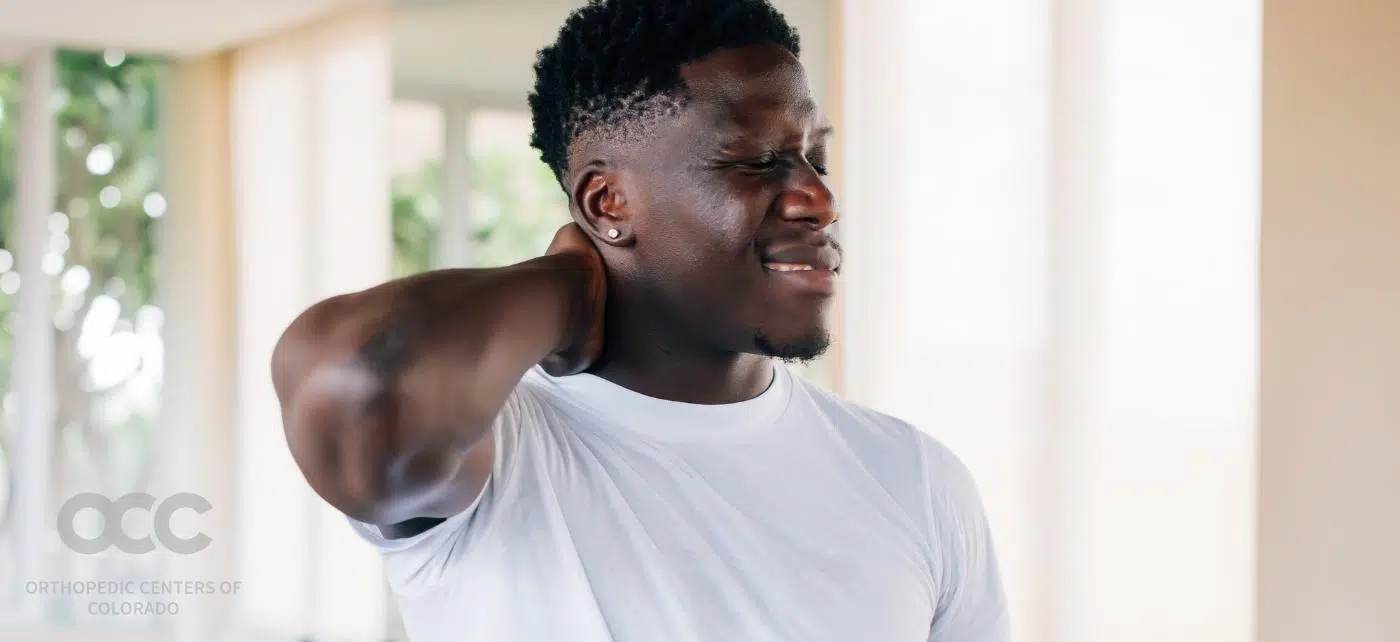Back pain is a common affliction that can sneak up without warning. Every movement can make it worse, limiting everyday activities. Those who suffer from debilitating back pain hear terms like “bulging discs” and “herniated discs” but might not necessarily understand what the difference is between them. With a detailed medical evaluation, the skilled and experienced spine and neck surgeons at Advanced Orthopedic in Denver, Parker, and Aurora, Colorado, can determine whether pain stems from a bulging disc, herniated disc, or even a combination of both, and from there, create a treatment plan to alleviate that pain best.
OVERVIEW
The spine is responsible for giving the body its support. There is some degree of protection given to the more valuable internal structures like the spinal cord and spine itself, but often, as a natural result of aging or injury, it can be prone to developing semi-severe complications like bulging discs and herniated discs. Disc problems are sometimes lumped together under the term degenerative disc disease, but it is important to understand that the two are not terms for the same conditions.
THE SPINE
The adult spine is made up of 24 interlocking bones called vertebrae. The spine has three main segments, top to bottom; cervical, thoracic, and lumbar. It is also called the backbone, spinal column, and vertebral column. The three main functions of the spine are to: protect the spinal cord, nerve roots, and several of the body’s internal organs, provide structural support and balance to maintain an upright position, and enable flexible motion.
THE FUNCTION OF DISCS
There is a total of 23 spinal or intervertebral discs. Discs are composed of two parts: a tough outer portion and a soft inner core. The configuration has been likened to that of a jelly donut. They act as shock absorbers in the spine, positioned between each bony vertebrae, and they are cartilaginous joints that allow for mobility in the spine. By early adulthood, the soft inner material begins to harden, and the disc is less elastic. By middle age, the discs are tough and quite unyielding, with the consistency of a piece of hard rubber. This degeneration related to aging makes the outer protective lining weaker and the discs more prone to injury such as bulging or herniated discs.
WHAT ARE BULGING DISCS?
A bulging disc is like letting air out of a tire. The disc sags and looks like it is bulging outward. It is also known as a “slipped disc.” When it bulges or “slips,” it causes the spine to become compressed. The surrounding area may become swollen, but more importantly, the nerves can get trapped or irritated. A bulging disc is usually caused by wear and tear caused by degenerative disease or active trauma to the spine, which can be brought by injury, repetitive movement, poor posture, or improper form when lifting heavy objects. It can also be the result of a hereditary condition. Bulging discs usually affect multiple discs and usually occur at the bottom of the lumbar spine.
SYMPTOMS
Symptoms of a bulging disc depend on its severity and location in the spine. Symptoms of a bulging disc also don’t happen all at once because it progresses very slowly from the initial point of damage. The most common symptoms include tingling, numbness or pain in the fingers, hands, arms, neck or shoulders, pain in the feet, thighs, lower spine, and buttocks, difficulty walking, or feeling of impairment while lifting or holding things. When the sciatic nerve is affected, the sensations are present down one leg or the other, but usually not both. Bladder incontinence can occur because of a bulging disc compressing the nerves that control the bladder. Upper back pain radiating to the stomach or chest may be a symptom of a mid-spine bulging disc. If left untreated, bulging discs have the potential to herniate and, over time, can cause more serious conditions like spinal stenosis (narrowing of the spinal canal).
WHAT ARE HERNIATED DISCS?
A herniated disc—also referred to as a “ruptured disc”, means the core of the disc has spilled out of its protective sheath entirely. They are considered more severe than bulging discs because they put significant pressure on nearby nerves. Herniated discs are a leading cause of neck and/or back and back and/or leg pain. They can happen anywhere along the spine, but herniated discs most often occur in the lumbar region of the spine. Only 10% of these injuries affect the upper spine. Risk factors for a herniated disc include wear and tear of aging, sudden jarring motions, excess body weight, repetitive lifting, pulling, pushing, bending sideways and twisting, and genetics. Even frequent driving, being seated for long periods combined with the vibration from the motor vehicle engine can put pressure on the spine. Herniated discs occur more often in men than women and people 35 to 55 years old have a higher chance of getting a herniated disc.
SYMPTOMS
Some people may have no initial symptoms. However, with further disk degeneration and herniation, and based on which area of the spine is herniated, a person may experience the following:
- Back pain that worsens with movement, such as when sneezing
- Spasms in the back muscles
- Reduced mobility in the legs, knees, and ankles
- Decreased bladder and bowel control
- Numbness or tingling in a shoulder or arm that may go down to the fingers
- Headaches when lying down
- Pain in the lower back, buttocks, hamstring, calf, or feet
- Pain may also radiate to different areas of the body, such as arms or rib cage
WHEN TO SEE A DOCTOR
With the worsening of any symptoms, seeing a spine and neck specialist is important before pain, numbness, or weakness can increase to the point they can hamper daily activities. People should seek help at once if they experience a loss of bowel or bladder control, loss of feeling, or muscle control. Left untreated, there is the risk of developing more complicated problems such as permanent sciatic nerve damage.
TREATMENT OPTIONS-NON-SURGICAL AND SURGICAL
Fortunately, there is a spectrum of treatment options for bulging and herniated discs, many non-surgical. Short-term treatments can mean taking anti-inflammatory drugs (NSAIDs) such as ibuprofen, especially during flare-ups. Cortisone injections (epidural steroid injections) can provide longer-term relief because the medicine is injected into the area around the spinal nerves. Physical therapy is often used, not just to relieve pain, but to help educate patients on good body mechanics (such as proper lifting) which helps to prevent excessive wear and tear on the discs. Other options may include massage, ultrasound therapy, heat or cold, limited bed rest or braces, and support devices. Some “trial and error” will be necessary to ascertain the most effective combination of treatments. Non-surgical treatments may take four to six weeks for maximum effect.
WHEN IS SURGERY INDICATED?
If bulging discs cause lumbar stenosis and symptoms affect the quality of life, surgery is an option. The procedure is very patient-specific, based on the type and level of stenosis, but, in general, it involves decompressing the spinal canal so that the nerves are no longer compressed. This, in turn, relieves the pain. As with bulging discs, herniated discs may need to be resolved by surgery. There are multiple surgical techniques, including diskectomies to remove the herniated disc, laminectomies to remove part of the bone around a herniated disc and expand the spinal canal, artificial disc surgery to replace a damaged disc with an artificial one, and spinal fusion to directly join two or more vertebrae together to make the spine more stable. Surgery would be the last course of treatment except in emergencies.
GETTING THE RIGHT DIAGNOSIS
Navigating the complexities of bulging and herniated discs requires the best board-certified spine and neck surgeons like those at Advanced Orthopedic in Denver, Parker, and Aurora, Colorado. Their skilled spine specialists offer accessible, innovative, and personalized treatment plans to help diagnose and manage any pain related to bulging and herniated discs. In addition to a complete medical history and comprehensive physical exam, they may order tests such as X-rays, CT scans, or EMGs to help them pinpoint the exact source of the problem. At Advanced Orthopedic, they get it right, right away, with the goal of providing the best care and quality of life to people suffering from pain. Isn’t that what you deserve?









